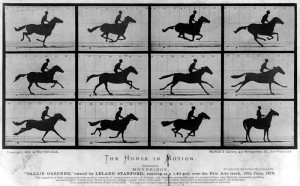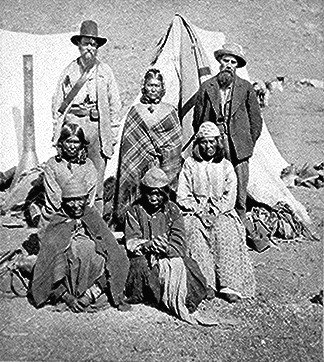Went to see the Tate’s exhibition of photographs by Eadward Muybridge on Sunday. Muybridge was the photographer who invented split-second photography and thus paved the way for moving pictures – famously to resolve the question of whether all four of a horse’s feet ever leave the ground at the same time. (They do.)
It was an interesting exhibition, but so much has previously been said about Muybridge that I can’t add much here, except to observe that Muybridge’s efforts to capture locomotion – a very Newtonian phenomenon – must have offered the first glimpse of the quantised future that lay ahead. Fascinating.
Other aspects of Muybridge’s career were much less familiar to me, including his work as a kind of proto-Ansel Adams photographing Yosemite National Park and a later stint as a would-be war photographer during the1872-1873 Modoc War. It doesn’t sound like Muybridge had much success in getting close to the action: most of his pictures of warlike Native Americans were staged with members of a completely different tribe to the Modocs. The authentic pictures he did get were rather less dramatic:
One of the exhibits was a page of engravings based on Muybridge’s pictures, used as illustrations to accompany an article on the War in Harper’s Weekly of 21 June 1873. This passage caught my eye:
What to do with the captured Modocs is now an embarrassing question. It is held by the military authorities at Washington that the Modocs could not surrender as “prisoners of war” in sense known to nations where war is declared in accordance with constituted forms. Not having been so received, they are not entitled to considerations as prisoners of war.
Plus ça change, plus c’est la même chose, eh?


The Modoc War, and the terrain thereof, is fascinating. The Navajo that Giraud’s Blueberry helps hide in spectacular desert caves were partly based on the Modoc, and Giraud’s spectacular visualizations were based on the caves the actual Modoc used as a base of operations and place of hiding and safety during the conflict. The area is now the Lava Beds National Monument, and it is one of the most amazing landscapes I have ever seen. The lava cooled into ridges fifteen to thirty feet wide with sheer fifty to one-hundred foot drops on either side – it’s the labial maze of mother earth, glassy rocks as dentata. She welcomes and she shelters and she kills and she eats. We visited on a bright, unseasonably warm first of December in 2008.
Beyond the ‘fortress’ there are numerous easy-access caves, and these appear to have inspired the Blueberry drawings.
I’m disappointed to report that the interpretive tour did not mention the prisonniers hors de combat.
Thanks, mwhybark – glad you’re still reading (if surprised; I’d have thought my endless jiggering around with this site would have shaken off my few remaining readers long ago). Sounds amazing; another pin to stick in the travel map.